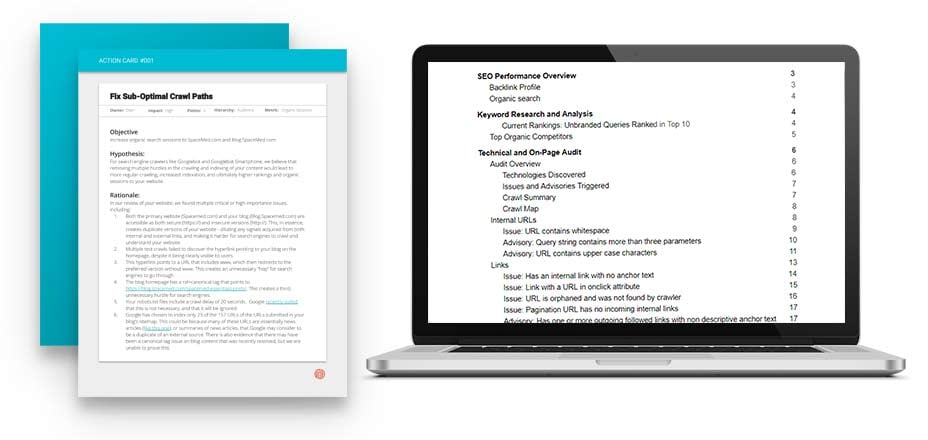Written By:
Ryan Sylvestre
An SEO audit includes powerful insights into a website’s health and the SEO factors that may be holding back a site from ranking naturally in search results. The issue with an SEO audit is for some, it can feel a little vague. What is this audit checking for? Will it have a positive ROI?
In this blog post, we will cover all of these questions and address the following:
- How do you do an SEO audit?
- What should be included in a website audit?
- What is an SEO audit tool?
- How do you do SEO analysis?
Want to try it for yourself? Download our 187 Point Self Audit Checklist!

How do you do an SEO audit?
Any company, agency, or freelancer will perform and pull together an SEO audit in a different way. Here at Pepperland Marketing, we do a variety of things that will give you the full scope of issues on your site. We follow a set of steps that allow us to carefully examine each aspect of your site during the auditing process.
1. Run a full website crawl/audit
We first need to run a full crawl/audit of your website to emulate how a search engine would do it. While this is usually the first and only step for many agencies, we take everything one step further by looking at more than one audit source.
2. Understand key points of crawl/audit report
Once we have our initial findings, we will look through each section of our audit. Our audits include checks in the following categories:
- Broken Links
- Internal Links
- On-Page SEO
- Indexability
- Redirects
- XML Sitemaps
- Organic rankings
- Google Search Console
- Google Analytics
- Page Speed/ Core Web Vitals
- Duplicate Content
- Front End
- Mobile Friendly
- Security
- Organic search traffic
When we identify a section of the site under-performing, our team of SEO experts will do a deep dive in that particular section and perform manual page by page reviews to uncover any hidden issues that the tool may not have picked up.
3. Documentation & Resolution
After we have a full understanding of the inner workings of a site, we will pull together full documentation. Our documentation has been as long as 100+ pages and as short as 45, it all depends on the severity of issues on a site.

4. Manual Page-By Page Review
Like we said before, if a particular section of a site is under-performing we will do a deep dive and check each page manually for issues. Page by page reviews are tedious but a necessary part of any audit. Doing manual reviews not only uncovers additional concerns, it allows us to understand the inner workings of pages templates, element configurations, and more. Having this deep understanding allows our team to provide solutions that can be implemented quickly.
What should be included in a website audit?
What’s included in a website audit report is always up for debate. Put simply, a website audit should include a full picture of the website hierarchy and all issues standing in the site’s way of improved performance.
It’s difficult to provide a list of things we think should be in a technical audit but the list of checked issues in section 2 is a good start. In general, we want to check these areas:
- Technical considerations and Core Web Vitals performance
- Current backlinks and referring pages pointing to your site for link building purposes
- On-page elements like title tags and meta descriptions
- Look at current content conversion opportunities
- Aspects of your site that disrupt the user experience
- Crawl waste & crawl budget
The list above is more vague than the one we included in the beginning but these sections encompass everything in that list. We provide all of this information in our audits and we organize it in a way so you understand what the issue is, what it means, where it’s found, and how to resolve it.
What is an SEO audit tool?
An SEO audit tool is just that, a tool. A tool can’t give you the insights that a trained eye can. Now, we’re not saying that tools are bad, they do a great job of highlighting potential pitfalls of a site. Once we have identified these sections, our trained technical specialists will do further analysis to uncover what’s causing the problem.
The reason for this double-analysis is because tools can’t tell a story as well as a human can. Once we find the root of the problem, we can accurately describe what’s happening behind the scenes and what we can do to stop it from happening in the future.
How do you do SEO analysis?
Providing SEO analysis takes a long time to nail down and get good at. Our specialists here at Pepperland have been trained and have practiced diagnosing issues over several audits we’ve performed for other businesses.
The concept I want to stress is that just having an SEO tool is half the battle. To get real insights and real results, you need someone who can explain and walk through specific issues and provide a solution. With each issue we spike out in our audits, we provide a path to a resolution which you can then decide to take in-house or get external help to solve.
When is the right time to get an SEO Audit?
When your organic traffic declines, traffic begins to stall, before, during, and after a redesign, or when things are going well. Most of the time we are auditing a website that is in need of a bit of redirection. We help them get back on track with their goals and leave with a much healthier site. When things are going well is another time to consider an audit. You’ll be surprised at what you can find.
There is never really a bad time to get an audit. Most of the time when people decide to get an audit, it’s too late. They have already seen traffic decline, loss of important and valuable keywords, or their content is getting dropped from search results.
The best time to get an audit is right now. If you’re already considering it, it’s probably the right time to do it. You don’t want to wait too long until you start seeing a drop in performance. Here at Pepperland Marketing, we offer technical audit services that will uncover everything in your way so you can wipe out the competition.







